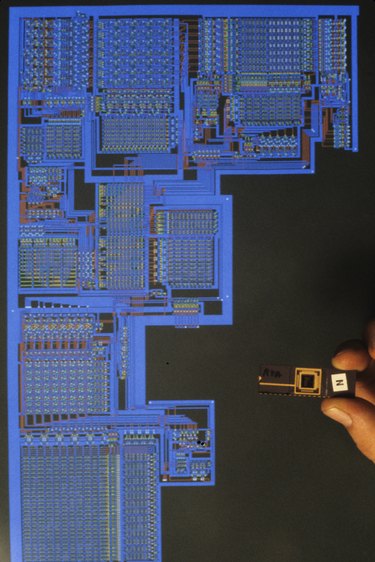
Mobile technology developed over decades by sometimes astonishing feats of engineering and mobile phones are now used in nearly every country on Earth. First introduced in the 1940s, handling only single calls and nothing else, mobile technology has since undergone several revolutionary advances, including cellular service, highly sophisticated electronics and powerful, lightweight batteries.
Cellular Radio Service
Video of the Day
Mobile phones rely on a cellular radio system that lets callers move about freely while facilitating millions of simultaneous calls. The system works through a network of radio towers, each of which has a range of a few miles. In most areas, tower coverage area overlaps. As you move, your phone detects one cell signal weakening and another strengthening. The network automatically switches you from one tower to another in a process called handoff
Video of the Day
Tiny, Powerful Electronics
Improvements in electronic components have driven the modern mobile phone development. In particular, the power of phones increases as parts become increasingly miniaturized, enabling more and more to be packed into a small package. As component size decreased, phones became slimmer, lighter and more energy-efficient. For example, every mobile phone contains a radio transmitter and receiver. The earliest cellphone transmitter and receiver required pounds-worth of components. Now, these two circuits are reduced to a single chip a few millimeters square.
Microprocessors, non-existent in the earliest mobile phones, now have the power for the latest games and sophisticated apps, not to mention movies and music. Also, advances in memory storage -- in the onboard chips and, sometimes, expansion slots for SD cards -- have transformed mobile phones into little PCs. Most mobile phones also include front and rear-facing cameras, some that rival expensive cameras. Cellphones have gradually eliminated the need for a separate device for photos and videos.
Compact, Lightweight Batteries
Mobile phones -- as indicated by their name -- are valued for their portability. Portability requires a battery to free you from power cords -- at least until it needs recharging. The earliest mobile phones ran from a vehicle's electrical system. Later phones used standard replaceable batteries as well as rechargeable nickel-cadmium types. The introduction of the lithium-ion battery, however, enabled mobile phones to both get through the day without recharging as well as power the added functionality and especially the brilliant, eye-catching displays.
Display Refinement
Modern cellphone screens rival and even beat the image quality found in full-size computer displays. Screen size has grown over the years and now takes up almost the entire front surface of the phone -- from 4 to 6 inches diagonally, at time of publication. Screen resolution has also increased, rendering clarity for infinitesimal details.
Full keyboards eventually replaced the number keypad in some devices. Those physical keyboards are now mostly replaced by an on-screen keyboard on a touch-screen display. Touch screens were tricky to manipulate when first introduced to the mobile phone but now have refined touch sensitivity, permitting control of the phone though finger taps and swipes.
Many users now want screen size big enough to view comfortably while remaining convenient and portable. These larger mobile phones have started to take the place of tablets in the lives of users, earning them the nickname phablets.